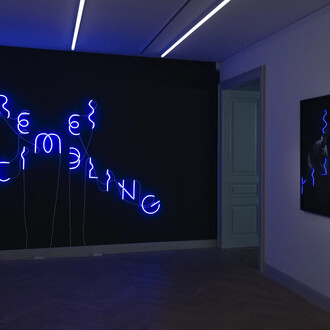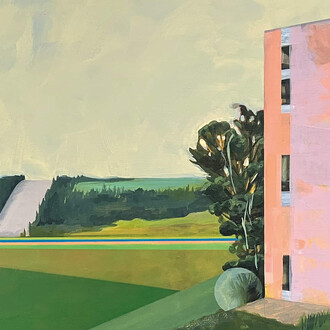Since many years, Gina Folly's work deeply engages with the medium photography, which she extends and complements with new forms and modes of presentation. The political, economic, cultural and social events and phenomena, as well as ecological questions influencing her precise reflection and analysis of her immediate surroundings often play an elemental role in her installation works. Human beings in their self-created environment — between naturalness and artificiality, within a steady creation of respective concepts of life — are further objects of Folly’s interest. For the annual exterior project 2019, Ines Goldbach met the artist for a dialog.
Ines Goldbach: I’d like to talk to you about your unique approach to photography, the central medium of your artistic practice, which concurrently is always conceptualized within space and installation. By tracing everyday things and situations, recognizing and capturing them specifically through the photographic eye, you’re questioning your surroundings comprehensibly and humorously, yet with an ironic and delicate criticism, among other things generating room installations from them. With that and various other reasons in mind, the design of the front banner to me seems very fitting within your work. Everyday life, naturalness and artificiality, reality and exaggeration are meeting here, and you’re simultaneously opening a secondary architectural space with it. Let’s begin with how you arrived at this motif you’re showing here.
Gina Folly: In spring 2018, I had the opportunity for a three month residency at the Swiss Institute New York. Luckily, I could stay with a very close, old friend of mine during that time. The motif of the banner for the Kunsthaus is a picture of his bookcase. But it’s not just the picture of a personal library, it also implies something universal. To me, the image is a placeholder for friendship, love, past, future and imagination, maybe in one word: for life. At the same time, the motif contains several important layers that appear frequently throughout my practice. On the one hand, this particular bookcase contains very personal, private and intimate issues and publications, books that my friends made for example; on the other, there are texts that gave context and meaning to the development of my own works; and lastly, it’s also the collection of books and the categorization of the bookcase of a friend. All this makes the motif both, an encyclopedia of my personal life and a motif that remains valid in a more universal, abstract sense.












